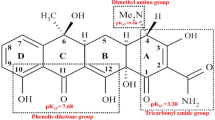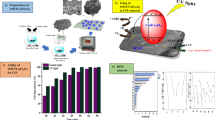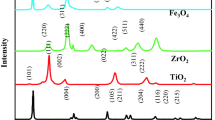Abstract
Pharmaceutical pollutants are among the most important issues in human life. The reason for investigating and controlling environmental pollution is the entry of these pollutants into the food cycle and drug resistance, which causes many environmental risks. In this study, the rate of photocatalytic degradation of TMP, a model organic pollutant, was investigated using NiFe2O4@MoO3 nanocomposites. The characteristics of the nanocomposites were identified using XRD, FESEM, EDX, and VSM techniques. This study aimed to explore the effects of different factors on the photocatalytic removal of the trimethoprim antibiotic (TMP) using a central composite design (CCD) and response surface method (RSM). Significant variables were identified, including initial pH (3–9), catalyst dose (5–100 mg/L), pollutant concentration (20–100 mg/L), and contact time (0–120 min), and 30 experiments were conducted to optimize the process. Statistical analysis based on analysis of variance (ANOVA) showed that the following factors influenced the response. In addition, the results showed that the efficiency of the photocatalytic process increased with an increase in catalyst and residence time, and the efficiency of the photocatalytic process increased with an increase in pH up to 6.3. RSM results revealed the best experimental conditions for TMP degradation under UV light. They showed that the initial pollutant concentration and pH had a greater impact on the degradation process than did the catalyst dose and retention time. This suggests that optimizing operational factors can significantly improve the performance of photocatalytic processes for removing antibiotics such as trimethoprim.
Graphical Abstract












Similar content being viewed by others
References
Ezzariai, A., Hafidi, M., Khadra, A., Aemig, Q., El Fels, L., Barret, M., et al. (2018). Human and veterinary antibiotics during composting of sludge or manure: Global perspectives on persistence, degradation, and resistance genes. Journal of hazardous materials., 359, 465–481.
Ahmed, M. B., Zhou, J. L., Ngo, H. H., Guo, W., Thomaidis, N. S., & Xu, J. (2017). Progress in the biological and chemical treatment technologies for emerging contaminant removal from wastewater: A critical review. Journal of hazardous materials., 323, 274–298.
Naghizadeh, A., Momeni, F., & Derakhshani, E. (2017). Efficiency of ultrasonic process in regeneration of graphene nanoparticles saturated with humic acid. Desalination and Water Treatment., 70, 290–293.
Ahmadian, M., Derakhshankhah, H., & Jaymand, M. (2023). Recent advances in adsorption of environmental pollutants using metal–organic frameworks-based hydrogels. International Journal of Biological Macromolecules, 231, 123333. https://doi.org/10.1016/j.ijbiomac.2023.123333.
Naghizadeh, A., Etemadinia, T., Derakhshani, E., & Esmati, M. (2023). Graphitic carbon nitride loaded on powdered mesoporous silica nanoparticles for photocatalytic tetracycline antibiotic degradation under UV-C light irradiation. Research on Chemical Intermediates., 49(3), 1165–1177.
Linghu, K., Wu, Q., Zhang, J., Wang, Z., Zeng, J., & Gao, S. (2023). Occurrence, distribution and ecological risk assessment of antibiotics in Nanming river: Contribution from wastewater treatment plant and implications of urban river syndrome. Process Safety and Environmental Protection., 169, 428–436.
Xu, Z., Jia, Y., Huang, B., Zhao, D., Long, X., Hu, S., et al. (2023). Spatial distribution, pollution characteristics, and health risks of antibiotic resistance genes in China: A review. Environmental Chemistry Letters, 21, 2285–2309.
de Nies, L., Kobras, C. M., & Stracy, M. (2023). Antibiotic-induced collateral damage to the microbiota and associated infections. Nature Reviews Microbiology, 21(12), 789–804.
Das, M. K., Das, S., & Srivastava, P. K. (2023). An overview on the prevalence and potential impact of antimicrobials and antimicrobial resistance in the aquatic environment of India. Environmental Monitoring and Assessment., 195(9), 1015.
Derakhshani, E., & Naghizadeh, A. (2014). Ultrasound regeneration of multi wall carbon nanotubes saturated by humic acid. Desalination and Water Treatment., 52(40–42), 7468–7472.
Sanusi, I. O., Olutona, G. O., Wawata, I. G., & Onohuean, H. (2023). Occurrence, environmental impact and fate of pharmaceuticals in groundwater and surface water: A critical review. Environmental Science and Pollution Research., 30(39), 90595–90614.
Montoya-Hinojosa, E. I., Salazar-Sesatty, H. A., Alvizo-Baez, C. A., Terrazas-Armendariz, L. D., Luna-Cruz, I. E., Alcocer-González, J. M., et al. (2023). Antibiofilm and antimicrobial activity of curcumin-chitosan nanocomplexes and trimethoprim-sulfamethoxazole on Achromobacter, Burkholderia, and Stenotrophomonas isolates. Expert Review of Anti-infective Therapy., 21(2), 213–223.
Mpatani, F. M., Aryee, A. A., Kani, A. N., Han, R., Li, Z., Dovi, E., et al. (2021). A review of treatment techniques applied for selective removal of emerging pollutant-trimethoprim from aqueous systems. Journal of Cleaner Production., 308, 127359.
Dian, S., Ganiem, A. R., & Ekawardhani, S. (2023). Cerebral toxoplasmosis in HIV-infected patients: A review. Pathogens and Global Health., 117(1), 14–23.
de Ilurdoz, M. S., Sadhwani, J. J., & Reboso, J. V. (2022). Antibiotic removal processes from water & wastewater for the protection of the aquatic environment-A review. Journal of water process engineering., 45, 102474.
Luo, S., Zhao, Z.-Y., Liu, Y., Liu, R., Liu, W.-Z., Feng, X.-C., et al. (2023). Recent advancements in antibiotics containing wastewater treatment by integrated bio-electrochemical-constructed wetland systems (BES-CWs). Chemical Engineering Journal., 457, 141133.
Sahay, P., Mohite, D., Arya, S., Dalmia, K., Khan, Z., & Kumar, A. (2023). Removal of the emergent pollutants (hormones and antibiotics) from wastewater using different kinds of biosorbent—A review. Emergent Materials., 6(2), 373–404.
Manna, M., & Sen, S. (2023). Advanced oxidation process: A sustainable technology for treating refractory organic compounds present in industrial wastewater. Environmental Science and Pollution Research., 30(10), 25477–25505.
Reza, K. M., Kurny, A., & Gulshan, F. (2017). Parameters affecting the photocatalytic degradation of dyes using TiO 2: A review. Applied Water Science., 7, 1569–1578.
Constantino, D. S., Dias, M. M., Silva, A. M., Faria, J. L., & Silva, C. G. (2022). Intensification strategies for improving the performance of photocatalytic processes: A review. Journal of Cleaner Production., 340, 130800.
Khader, E. H., Mohammed, T. J., Albayati, T. M., Harharah, H. N., Amari, A., Saady, N. M. C., et al. (2023). Current trends for wastewater treatment technologies with typical configurations of photocatalytic membrane reactor hybrid systems: A review. Chemical Engineering and Processing-Process Intensification, 192, 109503.
Hassanzadeh, S., Eisavi, R., & Abbasian, M. (2019). Green synthesis of thiiranes from epoxides catalyzed by magnetically separable CuFe2O4/Mg (OH) 2 nanocomposite in water under benign conditions. Journal of Sulfur Chemistry., 40(3), 240–255.
Ramazani, A., Taghavi Fardood, S., Hosseinzadeh, Z., Sadri, F., & Joo, S. W. (2017). Green synthesis of magnetic copper ferrite nanoparticles using tragacanth gum as a biotemplate and their catalytic activity for the oxidation of alcohols. Iranian Journal of Catalysis., 7(3), 181–185.
Dippong, T., Cadar, O., & Levei, E. A. (2022). Effect of transition metal do** on the structural, morphological, and magnetic properties of NiFe2O4. Materials., 15(9), 2996.
Arumugham, N., Mariappan, A., Eswaran, J., Daniel, S., Kanthapazham, R., & Kathirvel, P. (2022). Nickel ferrite-based composites and its photocatalytic application–A review. Journal of Hazardous Materials Advances, 8, 100156.
Derakhshani, E., Naghizadeh, A., & Mortazavi-Derazkola, S. (2024). Superior UVC light-mediated catalytic activity of a novel NiFe2O4@ TiO2 magnetic nanocomposite synthesized with green route using Pulicaria Gnaphalodes plant extract for enhanced photocatalytic degradation of an antibiotic in water solution. Applied Water Science., 14(2), 17.
Yousefi, M., Gholami, M., Oskoei, V., Mohammadi, A. A., Baziar, M., & Esrafili, A. (2021). Comparison of LSSVM and RSM in simulating the removal of ciprofloxacin from aqueous solutions using magnetization of functionalized multi-walled carbon nanotubes: Process optimization using GA and RSM techniques. Journal of Environmental Chemical Engineering., 9(4), 105677.
Selvakumar, G., & Palanivel, C. (2022). A study on synthesis, characterization and catalytic applications of MoO3-ZnO nanocompositematerial. Materials Science for Energy Technologies., 5, 36–44.
Masoudi, F., Naghizadeh, A., Zardast, M., Gholami, A., Farrokhfall, K., Foadoddini, M., et al. (2020). Effects of bentonite nanoparticles inhalation on lung tissue and blood antioxidant indices in a rat model. Toxicology and Industrial Health., 36(1), 11–21.
Hosseini, H., & Mahdavi, H. (2018). Nanocomposite based on epoxy and MWCNTs modified with NiFe2O4 nanoparticles as efficient microwave absorbing material. Applied Organometallic Chemistry., 32(4), e4294.
Khairy, M. (2014). Synthesis, characterization, magnetic and electrical properties of polyaniline/NiFe2O4 nanocomposite. Synthetic metals., 189, 34–41.
Gebreslassie, G., Bharali, P., Chandra, U., Sergawie, A., Baruah, P. K., Das, M. R., et al. (2019). Hydrothermal synthesis of g-C3N4/NiFe2O4 nanocomposite and its enhanced photocatalytic activity. Applied Organometallic Chemistry., 33(8), e5002.
Wang, Q., Pang, W., Mao, Y., Sun, Q., Zhang, P., Ke, Q., et al. (2019). Study of the degradation of trimethoprim using photo-Fenton oxidation technology. Water, 11(2), 207.
Samy, M., Ibrahim, M. G., Alalm, M. G., Fujii, M., Ookawara, S., & Ohno, T. (2020). Photocatalytic degradation of trimethoprim using S-TiO2 and Ru/WO3/ZrO2 immobilized on reusable fixed plates. Journal of Water Process Engineering., 33, 101023.
Asri, M., Naghizadeh, A., Hasani, A., Mortazavi-Derazkola, S., Javid, A., & Masoudi, F. (2023). Sustainable green synthesis of ZnFe2O4@ ZnO nanocomposite using Oleaster tree bark methanolic extract for photocatalytic degradation of aqueous humic acid in the presence of UVc irradiation. AQUA—Water Infrastructure, Ecosystems and Society, 72(9), 1800–1814.
Derakhshani, E., & Naghizadeh, A. (2023). Recent advancement in NiFe2O4-based nanocomposites for the photocatalytic degradation of pollutants in aqueous solutions: A comprehensive systematic review. AQUA—Water Infrastructure, Ecosystems and Society, 72(8), 1629–1645.
González, B., Trujillano, R., Vicente, M. A., Rives, V., Korili, S. A., & Gil, A. (2019). Photocatalytic degradation of trimethoprim on doped Ti-pillared montmorillonite. Applied Clay Science., 167, 43–49.
Hossienzadeh, K., Maleki, A., Daraei, H., Safari, M., Pawar, R., & Lee, S. M. (2019). Sonocatalytic and photocatalytic efficiency of transition metal-doped ZnO nanoparticles in the removal of organic dyes from aquatic environments. Korean Journal of Chemical Engineering., 36, 1360–1370.
Almasi, A., Dargahi, A., Mohamadi, M., Biglari, H., Amirian, F., & Raei, M. (2016). Removal of Penicillin G by combination of sonolysis and photocatalytic (sonophotocatalytic) process from aqueous solution: Process optimization using RSM (Response Surface Methodology). Electronic physician., 8(9), 2878.
Esmati, M., Allahresani, A., & Naghizadeh, A. (2021). Synthesis and characterization of graphitic carbon nitride/mesoporous nano-silica (g-C3N4/KCC-1) nanocomposite as a novel highly efficient and recyclable photocatalyst for degradation of antibiotic in aqueous solution. Research on Chemical Intermediates., 47(4), 1447–1469.
Vasseghian, Y., Sezgin, D., Nguyen, D. C., Hoang, H. Y., & Yilmaz, M. S. (2023). A hybrid nanocomposite based on CuFe layered double hydroxide coated graphene oxide for photocatalytic degradation of trimethoprim. Chemosphere, 322, 138243.
Taie, M., Fadaei, A., Sadeghi, M., Hemati, S., & Mardani, G. (2021). Comparison of the efficiency of ultraviolet/zinc oxide (UV/ZnO) and ozone/zinc oxide (O3/ZnO) techniques as advanced oxidation processes in the removal of trimethoprim from aqueous solutions. International Journal of Chemical Engineering., 2021, 1–11.
Oros-Ruiz, S., Zanella, R., & Prado, B. (2013). Photocatalytic degradation of trimethoprim by metallic nanoparticles supported on TiO2-P25. Journal of hazardous materials., 263, 28–35.
Samy, M., Ibrahim, M. G., Alalm, M. G., & Fujii, M. (2020). MIL-53 (Al)/ZnO coated plates with high photocatalytic activity for extended degradation of trimethoprim via novel photocatalytic reactor. Separation and Purification Technology., 249, 117173.
Martínez-Costa, J., Rivera-Utrilla, J., Leyva-Ramos, R., Sánchez-Polo, M., & Velo-Gala, I. (2018). Individual and simultaneous degradation of antibiotics sulfamethoxazole and trimethoprim by UV and solar radiation in aqueous solution using bentonite and vermiculite as photocatalysts. Applied Clay Science., 160, 217–225.
Acknowledgements
The authors express their gratitude to Birjand University of Medical Sciences for their support
of the present study.
Funding
The current project accepted and financially support in Research deputy of BUMS coded 6268.
Author information
Authors and Affiliations
Contributions
All authors contributed to the study design. Synthesis of nanocomposites was done by Elham Drakhshani and Sobhan Mortazavi. Conceptualization of the research was done by Ali Naghizadeh. Material preparation, experiments, and data analysis were done by Sepideh sahragard and Ali Naghizadeh. The initial manuscript was written by Sepideh Sahragard. All authors read and approved the article.
Corresponding authors
Ethics declarations
Competing interests
The authors declare no competing interests.
Ethics Approval and Consent to Participate
The recent research project accepted in ethical committee of BUMS coded IR.BUMS.REC.1402.511. All authors consent to participate and publication of this paper.
Conflict of Interest
The authors affirm that there are no conflicts of interest related to the publication of this manuscript.
Additional information
Publisher's Note
Springer Nature remains neutral with regard to jurisdictional claims in published maps and institutional affiliations.
Rights and permissions
Springer Nature or its licensor (e.g. a society or other partner) holds exclusive rights to this article under a publishing agreement with the author(s) or other rightsholder(s); author self-archiving of the accepted manuscript version of this article is solely governed by the terms of such publishing agreement and applicable law.
About this article
Cite this article
Sahragard, S., Naghizadeh, A., Mortazavi-Derazkola, S. et al. Detoxification of Trimethoprim Antibiotic Using NiFe2O4@MoO3 Magnetic Nanocomposites Phyto-synthesized with Green Route: Experimental and RSM Modeling. BioNanoSci. 14, 1119–1131 (2024). https://doi.org/10.1007/s12668-024-01420-1
Accepted:
Published:
Issue Date:
DOI: https://doi.org/10.1007/s12668-024-01420-1




